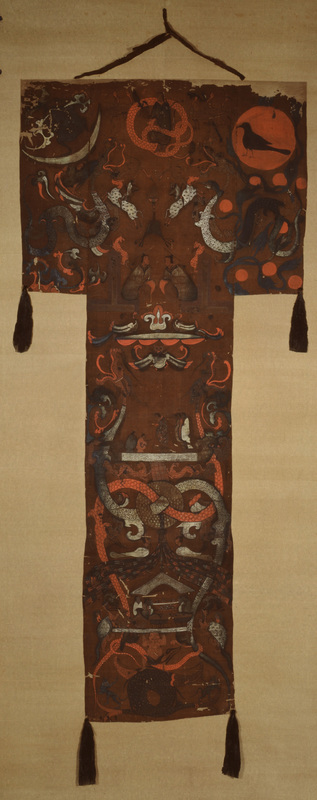T-Shaped Painting on Silk

Western Han Dynasty (206 BC-25 AD)
Length: 205cm; Width at top: 92cm; Width at bottom: 47.7cm
Unearthed from Mawangdui Han Tomb No.1 in 1972 in Changsha, Hunan Province
The T-shaped painting on silk, called feiyi (flying garment), was the banner carried in the funeral procession and then buried in the tomb for the purpose of calling back the spirit of the deceased. The painting can be divided into the heavenly world, the human world and the underworld.
The heavenly world depicts the myths and legends of Nv Wa (or the fire dragon, according to another theory), who has a human head and the body of a serpent; the golden crow; the toad and the jade hare; and Chang E, who flies to the moon. The golden crow represents the sun in the sense that “When the golden crow flies up from the bottom of the sea, red brilliance drives away dark clouds.”
In the human realm, Xin Zhui, the tomb’s occupant, is seen flying toward the heavenly world accompanied by three maids, while her family offers sacrifices and prayers for the safe ascent of her soul to heaven.
In the underworld we see the legendary whales and grotesque animals that guard the body of the deceased.
深入探索
Futher Exploration
The T-shaped Painting on Silk and the Legend of Resurrection
The painting sequentially depicts time in the conceptual universe of the people of the early Han dynasty; its two main themes are “guiding the spirit to heaven” and calling back the spirit to pacify the soul.” A more recent theory suggests that the T-shaped painting is not an independent work of art but a part of the tomb furnishings. It does not represent an independent, ready-made composition but grows out of funerary rituals. The primary purpose of the banner is to depict death within the framework of the entire Han Dynasty universe and to express the wish for resurrection. After burial, the Marquise of Dai will live in the underground “eternal home”. This banner is the best-preserved and earliest romantic painting in China’s history of fine arts.



